【C++】unordered_set和unordered_map的实现
【C++】unordered_set和unordered_map的实现
本篇unordered_set和unordered_map的实现基于:
自己实现的hash表 【C++】哈希表的实现(链地址法)
与map和set差不多的实现手法:【C++】模拟实现map和set
1.实现出复⽤哈希表的框架,并⽀持insert
创建3个头文件和一个源文件。
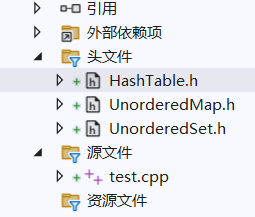
这个HashTable.h文件可以用之前写好的,可直接拷贝,再进行修改。
key参数就⽤K,value参数就⽤V,哈希表中的数据类型,我们使⽤T。
//HashTable.h文件
#pragma once
#include <iostream>
#include <vector>
#include<string>
using namespace std;
inline unsigned long __stl_next_prime(unsigned long n)
{
// Note: assumes long is at least 32 bits.
static const int __stl_num_primes = 28;
static const unsigned long __stl_prime_list[__stl_num_primes] =
{
53, 97, 193, 389, 769,
1543, 3079, 6151, 12289, 24593,
49157, 98317, 196613, 393241, 786433,
1572869, 3145739, 6291469, 12582917, 25165843,
50331653, 100663319, 201326611, 402653189, 805306457,
1610612741, 3221225473, 4294967291
};
const unsigned long* first = __stl_prime_list;
const unsigned long* last = __stl_prime_list + __stl_num_primes;
const unsigned long* pos = lower_bound(first, last, n);
return pos == last ? *(last - 1) : *pos;
}
namespace hash_bucket // 链地址法/哈希桶
{
template<class T>
struct HashNode
{
T _data;
HashNode<T>* _next;
HashNode(const T& data)
:_data(data)
,_next(nullptr)
{}
};
template<class K>
struct HashFunc
{
size_t operator()(const K& key)
{
return (size_t)key;
}
};
template<>
struct HashFunc<string>
{
size_t operator()(const string& s)
{
size_t hashi = 0;
for(auto ch : s)
{
hashi += ch;
hashi *= 131;
}
return hashi;
}
};
template<class K, class T, class KeyOfT, class Hash = HashFunc<K>>
class HashTable
{
typedef HashNode<T> Node;
public:
HashTable()
:_table(__stl_next_prime(0))
,_n(0)
{}
bool Insert(const T& data)
{
KeyOfT kot;
if (Find(kot(data)));
return false;
Hash hash;
if (_n == _table.size()) //扩容
{
vector<Node*> newtable(__stl_next_prime(_table.size() + 1));//创建新表
for (int i = 0; i < _table.size(); i++) //遍历旧表
{
Node* cur = _table[i];
while (cur) //遍历当前位置挂的所有节点
{
Node* next = cur->_next; //记录cur的下一个节点
size_t hash0 = hash(kot(cur->_data)) % newtable.size(); //计算在新表的位置
//直接把节点头插到新表
cur->_next = newtable[hash0];
newtable[hash0] = cur;
cur = next; //遍历这条链上的下一个节点
}
_table[i] = nullptr;
}
_table.swap(newtable);//旧表新表互换
}
size_t hashi = hash(kot(data)) % _table.size(); //映射位置
Node* newnode = new Node(data);
newnode->_next = _table[hashi];
_table[hashi] = newnode;
_n++;
return true;
}
Node* Find(const K& key)
{
KeyOfT kot;
Hash hash;
size_t hashi = hash(key) % _table.size();
Node* cur = _table[hashi];
while (cur)
{
if (kot(cur->_data) == key)
{
return cur; //找到了
}
cur = cur->_next;
}
return nullptr; //没找到
}
bool Erase(const K& key)
{
KeyOfT kot;
Hash hash;
size_t hashi = hash(key) % _table.size();
Node* cur = _table[hashi];
while (cur)
{
Node* prev = nullptr;
if (cur->_kv.first == key) //找到了
{
if (prev == nullptr) //删除节点为头节点
{
_table[hashi] = cur->_next;
}
else //删除节点为中间节点或尾节点
{
prev->_next = cur->_next;
}
delete cur;
_n--;
return true;
}
else
{
prev = cur;
cur = cur->_next;
}
}
return false; //删除失败
}
~HashTable()
{
for (int i = 0; i < _table.size(); i++)
{
Node* cur = _table[i];
while (cur)
{
Node* next = cur->_next;
delete cur;
cur = next;
}
_table[i] = nullptr;
}
}
private:
vector<Node*> _table;
size_t _n;
};
}//UnorderedSet.h文件
#include "HashTable.h"
template<class K>
class Unordered_Set
{
struct SetKeyOfT
{
const K& operator()(const K& key)
{
return key;
}
};
public:
bool insert(const K& key)
{
return _sht.Insert(key);
}
private:
hash_bucket::HashTable<K, K, SetKeyOfT> _sht;
};//UnorderMap.h文件
#include "HashTable.h"
template<class K, class V>
class Unordered_Map
{
struct MapKeyOfT
{
const K& operator()(const pair<K, V>& kv)
{
return kv.first;
}
};
public:
bool insert(const pair<K, V>& kv)
{
return _mht.Insert(kv);
}
private:
hash_bucket::HashTable<K, pair<K, V>, MapKeyOfT> _mht;
};这里的逻辑和自己实现map/set的逻辑是一样的,可参考那篇文章。
在test.cpp中测试一下,下面代码没出问题的话,就实现好了。
#include "UnorderedMap.h"
#include "UnorderedSet.h"
int main()
{
int a[] = { 4, 2, 6, 1, 3, 5, 15, 7, 16, 14, 3,3,15 };
Unordered_Set<int> us;
for (auto i : a)
{
us.insert(i);
}
return 0;
}2.⽀持iterator的实现
先把迭代器的结构写出来。
T是数据的类型,Ref是数据的引用,Ptr是数据的指针,KeyOfT是取Key,Hash是解决Key不能取模的仿函数。
//这里需要HashTable的前置声明
template<class K, class T, class KeyOfT, class Hash>
class HashTable;
template< class T, class Ref, class Ptr, class KeyOfT, class Hash>
struct HTIterator
{
typedef HashNode<T> Node;
typedef HashTable<K, T, KeyOfT, Hash> HT; //这里使用了HashTable,之前需要有他的声明
typedef HTIterator<K, T, Ref, Ptr, KeyOfT, Hash> Self;
Node* _node;
HT* _ht;
HTIterator(Node* node, HT* ht)
:_node(node)
,_ht(ht)
{}
};然后把几个简单的运算符重载的实现写出来。
template< class T, class Ref, class Ptr, class KeyOfT, class Hash>
struct HTIterator
{
typedef HashNode<T> Node;
typedef HashTable<K, T, KeyOfT, Hash> HT;
typedef HTIterator<K, T, Ref, Ptr, KeyOfT, Hash> Self;
Node* _node;
HT* _ht;
HTIterator(Node* node, HT* ht)
:_node(node)
,_ht(ht)
{}
Ref operator*()
{
return _node->_data;
}
Ptr operator->()
{
return &_node->_data;
}
bool operator!=(const Self& s)
{
return _node != s._node;
}
};2.1 operator++的实现
Self& operator++()
{
if (_node->_next)//如果当前桶不为空
{
_node = _node->_next;
}
else //当前桶不为空
{
//就要找下一个桶
}
}这里主要是解决怎么从一个桶找到下一个桶。
可以先计算当前位置的hashi,然后对这个hashi进行+1的操作,就能找到下一个桶。
Self& operator++()
{
if (_node->_next)//当前位置的下一个节点不为空
{
_node = _node->_next;
}
else //如果是当前桶的最后一个位置
{
//找下一个桶
KeyOfT kot; //取出Key
Hash hash; //解决Key不能取模问题
size_t hashi = hash(kot(_node->_data)) % _ht->_table.size();//找映射位置
hashi++; //下一个桶
}
}解释一下这句代码: hash(kot(_node->_data))。 我们不知道_node->_data是一个key还是一个pair,所以用kot(_node->_data)取出_data的key部分,这个key又不一定是能取模的类型,可能是string,所以用 hash(kot(_node->_data))来转换成能取模的。
下一个桶可能没有数据,我们要找下一个不为空的桶,所以还要while循环找,并且找的时候不能越界。
Self& operator++()
{
if (_node->_next)//如果当前桶不为空
{
_node = _node->_next;
}
else //当前桶不为空
{
//找下一个桶
KeyOfT kot;
Hash hash;
size_t hashi = hash(kot(_node->_data)) % _ht->_table.size();//找映射位置
hashi++;
while (hashi < _ht->_table.size() && _ht->_table[hashi] == nullptr)
{
hashi++;
}
}
}hashi < _ht->_table.size() && _ht->_table[hashi] == nullptr 这句代码的顺序不可交换,否则会发生越界访问。
出while循环后,可能是走到end位置了,也可能是找到不为空的桶了,所以要分情况讨论。
Self& operator++()
{
if (_node->_next)//如果当前桶不为空
{
_node = _node->_next;
}
else //当前桶不为空
{
//找下一个桶
KeyOfT kot;
Hash hash;
size_t hashi = hash(kot(_node->_data)) % _ht->_table.size();//找映射位置
hashi++;
while (_ht->_table[hashi] == nullptr && hashi < _ht->_table.size())
{
hashi++;
}
if (hashi == _ht->_table.size()) //走到表尾了,就是end的位置
{
_node = nullptr;
}
else //找到了不为空的桶
{
_node = _ht->_table[hashi];
}
}
return *this;
}解决 _table 为私有成员的问题
_table是HashTable这个类的私有成员,在HashTable类外不能访问,这里的解决方法就是用友元。在HashTable类里加上下面这两句话。
template<class K, class T, class Ref, class Ptr, class KeyOfT, class Hash>
friend struct HTIterator;
这是类模板的友元声明,不能只写friend struct HTIterator; 模板的友元声明连模板参数也要写上。
2.2 begin 和 end
在HashTable类里public对迭代器和const迭代器重命名。
public:
typedef HTIterator<K, T, T&, T*, KeyOfT, Hash> Iterator;
typedef HTIterator<K, T, const T&, const T*, KeyOfT, Hash> Const_Iterator;在HashTable类里public实现begin和end。
begin的实现就是找到这个表的第一个节点,也就是第一个不为空的桶。找到之后,我们返回一个迭代器,这个迭代器用一个结点的指针和HashTable的指针(this指针)构造。
Iterator Begin()
{
for (int i = 0; i < _table.size(); i++)
{
Node* cur = _table[i];
if (cur)
return Iterator(cur, this);
}
}如果遍历完了都没找到不为空的桶,就返回end。但是这里还可以加一个判断,_n为0的时候,这个表就是一个数据也没有,直接返回end。
Iterator Begin()
{
if (_n == 0)
return End();
for (int i = 0; i < _table.size(); i++)
{
Node* cur = _table[i];
if (cur)
return Iterator(cur, this);
}
return End();
}这个end就定义为空指针,但是实现的时候不能直接写return nullptr; 因为我们要返回一个迭代器,要用nullptr去构造这个迭代器。
Iterator End()
{
return Iterator(nullptr, this);
}现在我们要在UnorderSet.h文件和UnorderMap.h文件里实现begin和end。
//UnorderedSet.h文件
public:
typedef typename hash_bucket::HashTable<K, K, SetKeyOfT>::Iterator iterator;
iterator begin()
{
_sht.Begin();
}
iterator end()
{
_sht.End();
}//UnorderedMap.h文件
public:
typedef typename hash_bucket::HashTable<K, pair<K, V>, MapKeyOfT>::Iterator iterator;
iterator begin()
{
_mht.Begin();
}
iterator end()
{
_mht.End();
}在test.cpp中测试一下。
#include "UnorderedMap.h"
#include "UnorderedSet.h"
int main()
{
int a[] = { 4, 2, 6, 1, 3, 5, 15, 7, 16, 14, 3, 55, 15 };
Unordered_Set<int> us;
for (auto i : a)
{
us.insert(i);
}
auto it = us.begin();
while (it != us.end())
{
cout << *it << " ";
++it;
}
cout << endl;
return 0;
}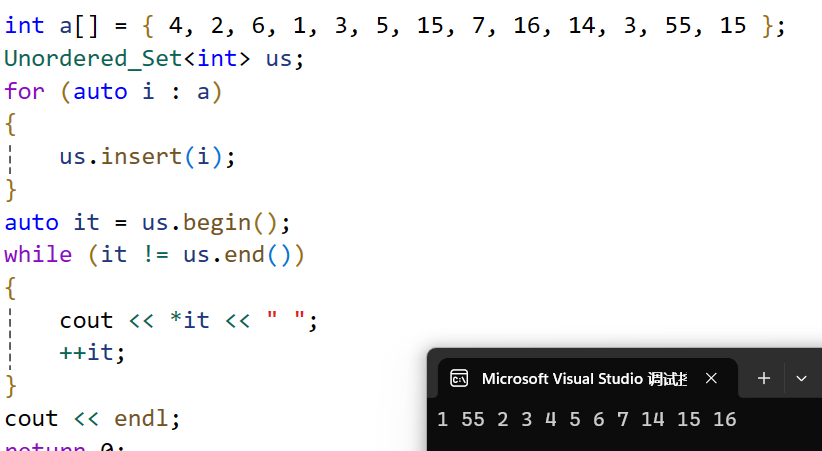
2.3 const迭代器
把const迭代器实现出来,和普通迭代器实现逻辑一样,返回值不同。
在HashTable.h文件中的HashTable类里添加下面代码。
Const_Iterator Begin() const
{
if (_n == 0)
return End();
for (int i = 0; i < _table.size(); i++)
{
Node* cur = _table[i];
if (cur)
return Const_Iterator(cur, this);
}
return End();
}
Const_Iterator End() const
{
return Const_Iterator(nullptr, this);
}此时参数列表括号后面的那个const修饰的是this,也就意味着this是一个const的,而我们前面在定义的时候,这个this类型并不是const的。
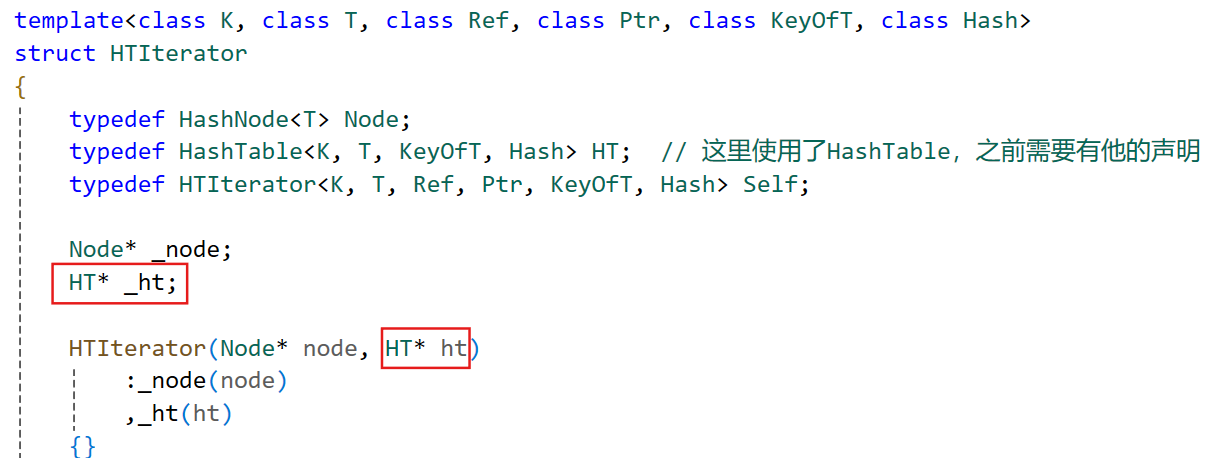
为了解决这个问题,我们需要把上面这个地方改为const。

在UnorderedSet.h文件中的Unordered_Set类里添加下面代码。
typedef typename hash_bucket::HashTable<K, K, SetKeyOfT>::Const_Iterator const_iterator;
const_iterator begin() const
{
return _sht.Begin();
}
const_iterator end()const
{
return _sht.End();
}在UnorderedMap.h文件中的Unordered_Map类里添加下面代码。
typedef typename hash_bucket::HashTable<K, pair<K, V>, MapKeyOfT>::Const_Iterator const_iterator;
const_iterator begin() const
{
return _mht.Begin();
}
const_iterator end() const
{
return _mht.End();
}在test.cpp中测试一下。
先测试unordered_set的。
void Print(const Unordered_Set<int>& s) //这里会用到const迭代器
{
Unordered_Set<int>::const_iterator cit = s.begin();
//auto cit = s.begin();
while (cit != s.end())//迭代器遍历
{
cout << *cit << " ";
++cit;
}
cout << endl;
for (auto i : s)//范围for遍历
{
cout << i << " ";
}
cout << endl;
}
int main()
{
int a[] = { 4, 2, 6, 1, 3, 5, 15, 7, 16, 14, 3, 55, 15 };
Unordered_Set<int> us;
for (auto i : a)
{
us.insert(i);
}
Print(us);
return 0;
}两种遍历方式都是没有问题的。
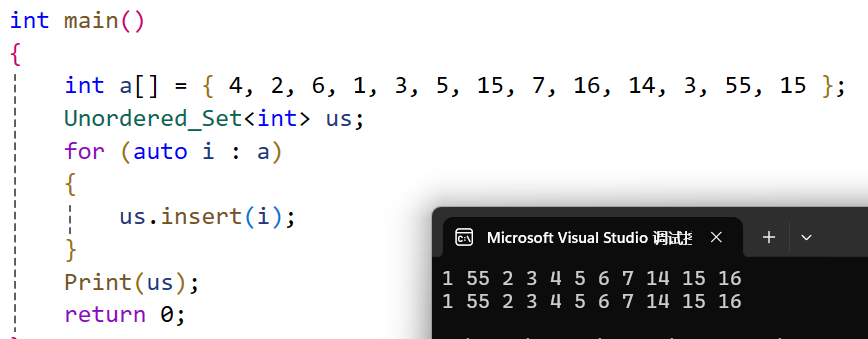
再测试一下unordered_map的。
void PrintMap(const Unordered_Map<string, string>& m)
{
Unordered_Map<string, string>::const_iterator cit = m.begin();
//auto cit = s.begin();
while (cit != m.end())//迭代器遍历
{
cout << cit->first << ":" << cit->second << endl;
++cit;
}
cout << endl;
for (auto s : m)//范围for遍历
{
cout << s.first << ":" << s.second << endl;
}
}
int main()
{
Unordered_Map<string, string> dic;
dic.insert({ "sort", "排序" });
dic.insert({ "left", "左边" });
dic.insert({ "watermelon", "西瓜" });
PrintMap(dic);
return 0;
}依旧是没有问题。
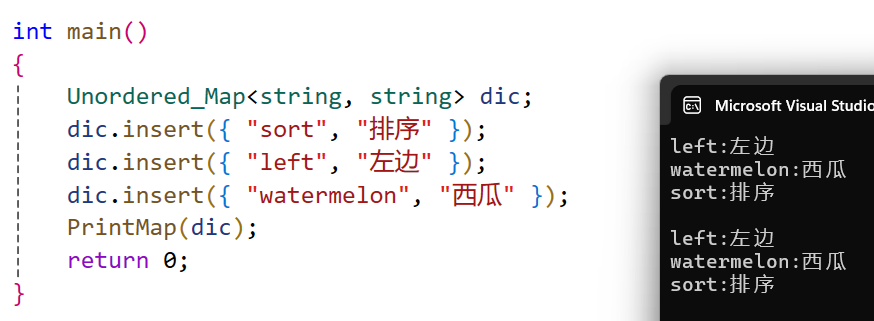
2.4 Key不可修改的实现
正常情况下,对于set而言,K不可修改,对于map而言,K不可修改,V可修改。
unordered_set修改如下。


unordered_map修改如下。


我们测试一下。
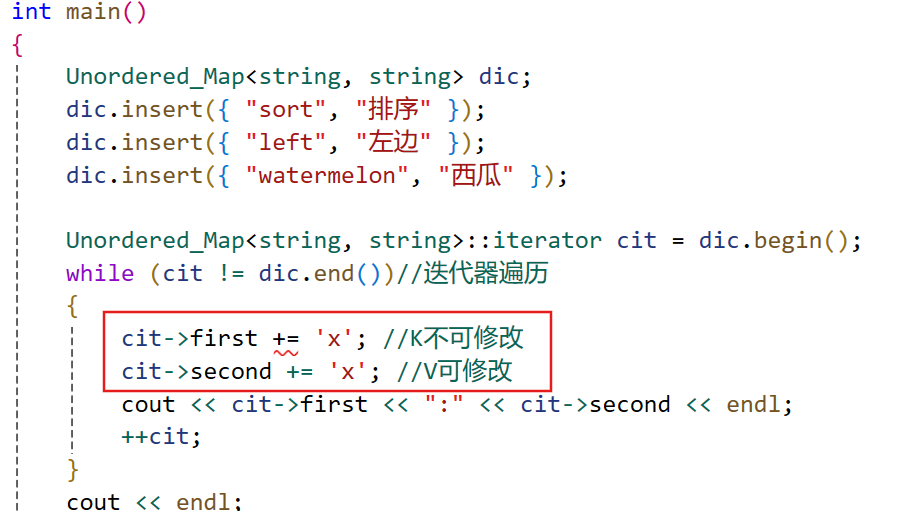
int main()
{
Unordered_Map<string, string> dic;
dic.insert({ "sort", "排序" });
dic.insert({ "left", "左边" });
dic.insert({ "watermelon", "西瓜" });
Unordered_Map<string, string>::iterator cit = dic.begin();
while (cit != dic.end())//迭代器遍历
{
//cit->first += 'x'; //K不可修改
cit->second += 'x'; //V可修改
cout << cit->first << ":" << cit->second << endl;
++cit;
}
cout << endl;
return 0;
}
3.operator[]的实现
operator[]的实现要用到find和insert,所以我们先把find和insert的返回值稍作修改,insert是返回一个pair,find返回一个迭代器。
在HashTable.h文件中要修改的代码。
Iterator Find(const K& key)
{
KeyOfT kot;
Hash hash;
size_t hashi = hash(key) % _table.size();
Node* cur = _table[hashi];
while (cur)
{
if (kot(cur->_data) == key)
{
return Iterator(cur, this); //找到了
}
cur = cur->_next;
}
return End(); //没找到,返回end
}
pair<Iterator, bool> Insert(const T& data)
{
KeyOfT kot;
Iterator it = Find(kot(data));
if (it != End()) //插入的值已存在,插入失败
return {it, false};//返回已存在的这个值的迭代器和false
Hash hash;
if (_n == _table.size()) //扩容
{
//...
}
size_t hashi = hash(kot(data)) % _table.size(); //映射位置
Node* newnode = new Node(data);
newnode->_next = _table[hashi];
_table[hashi] = newnode;
_n++;
return {Iterator(newnode, this), true};//插入成功,返回 新插入的值的迭代器 和 true
}
在UnorderedSet.h文件中要修改的代码并补充find的封装。
iterator find(const K& key)
{
return _sht.Find(key);
}
pair<iterator, bool> insert(const K& key)
{
return _sht.Insert(key);
}在UnorderedMap.h文件中要修改的代码并补充find的封装。
iterator find(const pair<K, V>& kv)
{
return _mht.Find(kv.first);
}
pair<iterator, bool> insert(const pair<K, V>& kv)
{
return _mht.Insert(kv);
}operator[]的实现和之前是一样的,代码如下。
//在 UnorderedMap.h 文件
V& operator[](const K& key)
{
pair<iterator, bool> ret = insert({ key, V() });
return ret.first->second;
}测试一下。
void PrintMap(const Unordered_Map<string, string>& m)
{
Unordered_Map<string, string>::const_iterator cit = m.begin();
while (cit != m.end())//迭代器遍历
{
cout << cit->first << ":" << cit->second << endl;
++cit;
}
}
int main()
{
Unordered_Map<string, string> dic;
dic.insert({ "sort", "排序" });
dic.insert({ "left", "左边" });
dic.insert({ "watermelon", "西瓜" });
PrintMap(dic);
cout << endl;
dic["left"] = "剩余"; //left已存在,修改
dic["right"] = "右边"; //right不存在,插入+修改
dic["banana"]; //banana不存在,插入
PrintMap(dic);
return 0;
}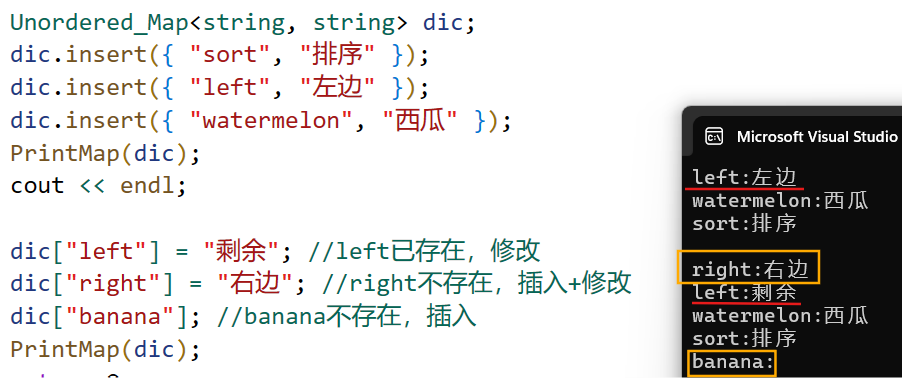
这个operator[]就实现好了。
4.最后的修改
由于Key不能取模的问题,我们设计了一个仿函数来解决。

但是这是在底层实现的,也就是哈希表这层,不好控制,所以我们要把对Hash这个仿函数的控制转移到上一层,也就是unordered_set和unordered_map这层。
做法就是把这里的缺省给去掉,

然后加在Unordered_Set和Unordered_Map类模板上。


这里增加了一个模板参数后,其他相应的地方也要改。
unordered_set和unordered_map的实现就到这里,我们下篇见~

